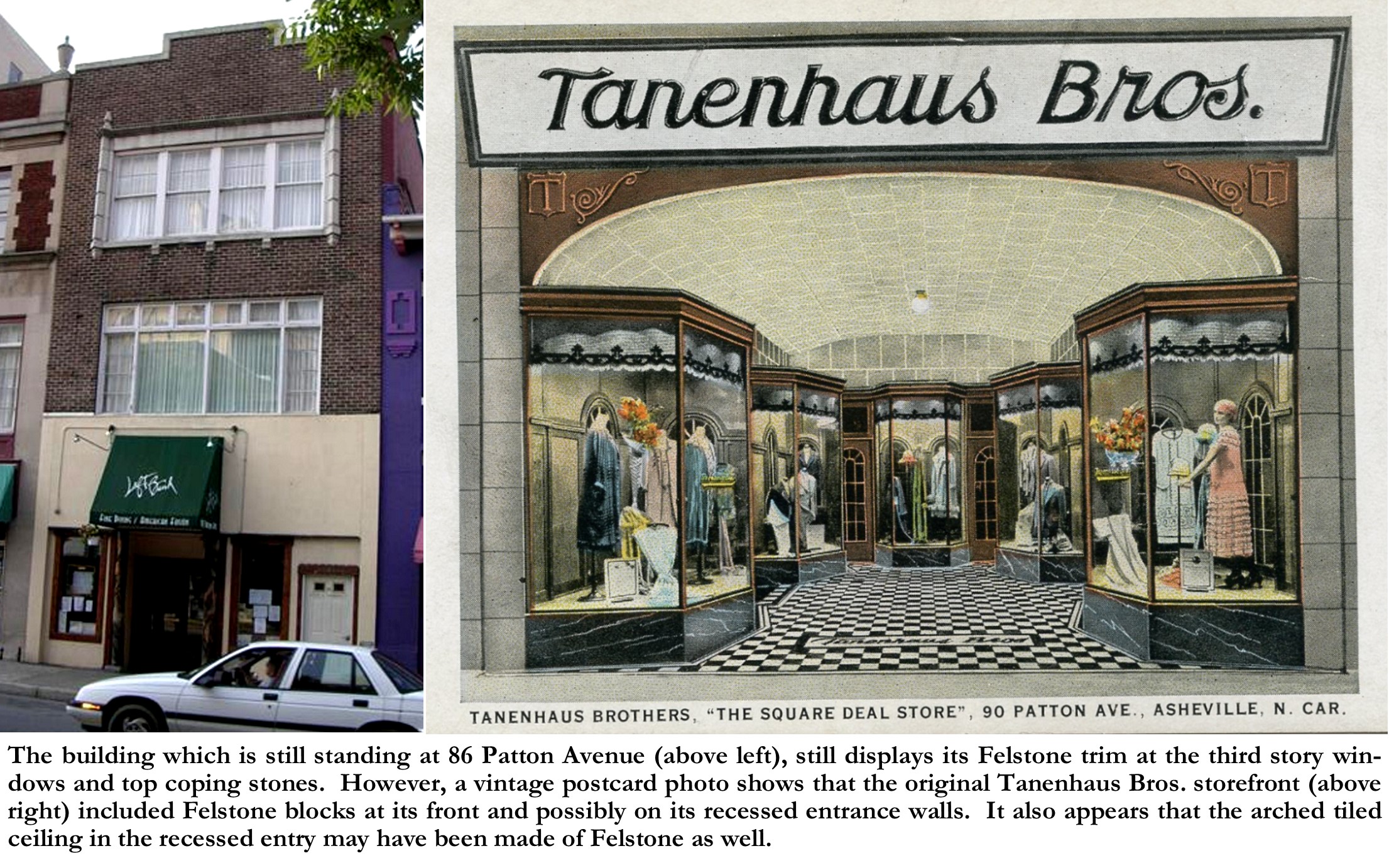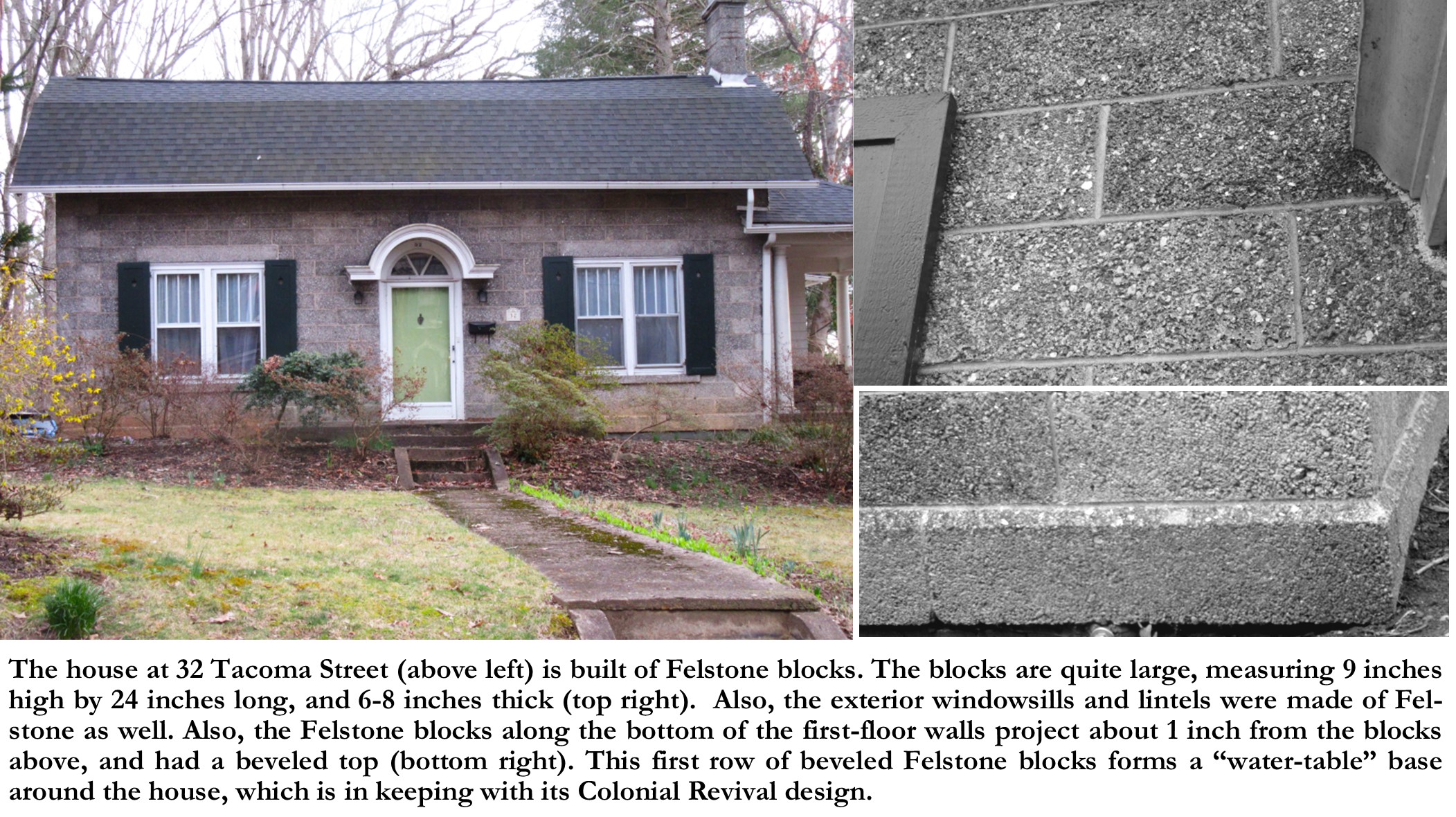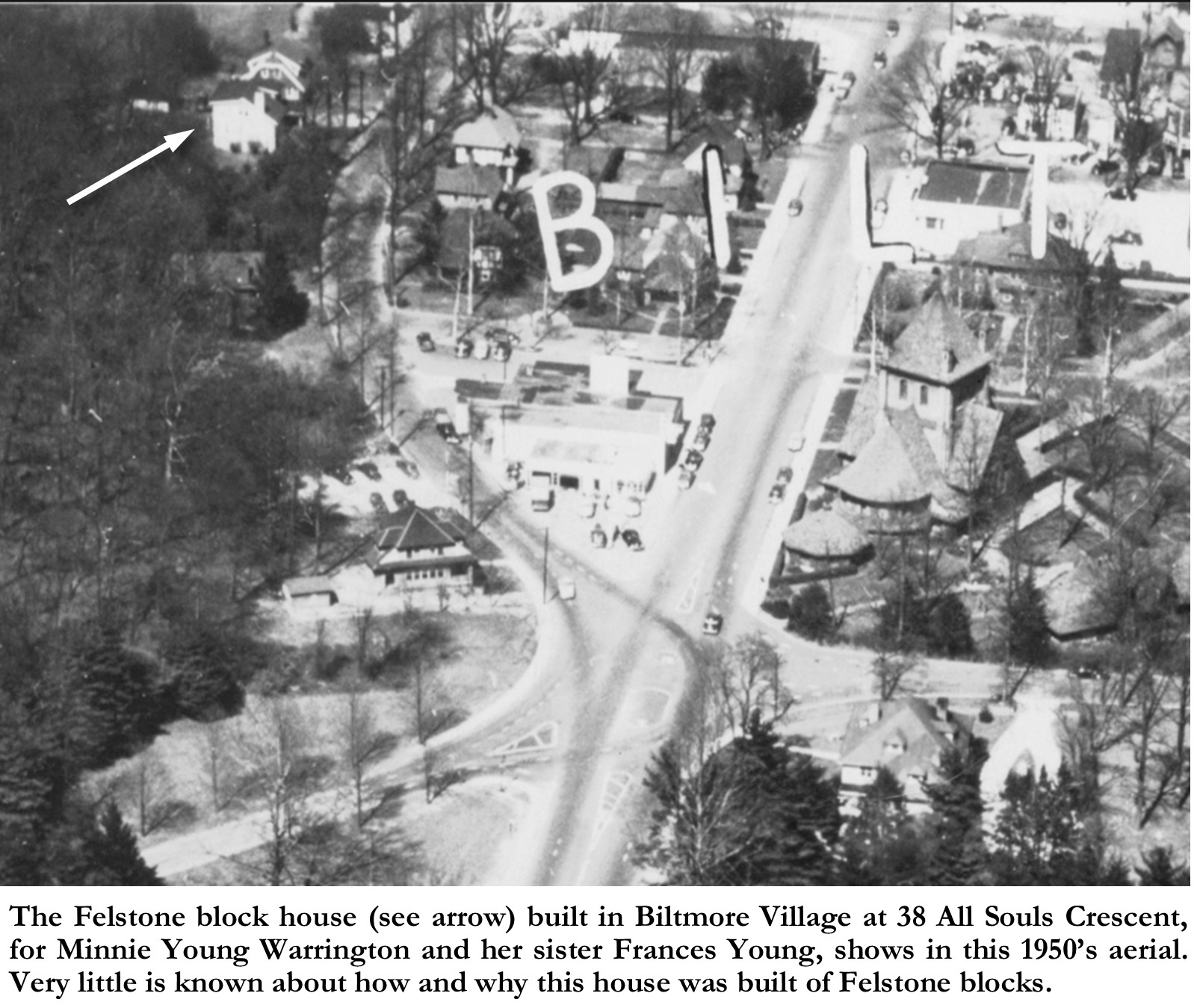by Dale Wayne Slusser
Often when researching the architectural history of a house or building, one tends to “go down rabbit trails”, seemingly off track from the object of the research. But sometimes those rabbit trails lead to a related and often more interesting topic. Such was the case with “Felstone”! While researching a house in the Fenner Heights subdivision in North Asheville, and more specifically, while researching one of the developers of the 1925-26 extension of Fenner Heights (named Hy-Vu Terrace), I stumbled across C. Marshall Gravatt who led me to the discovery of “Felstone”. What was “Felstone”? The short answer is that it was simultaneously, the name of a building materials manufacturer as well as the name of its varied products. Here is the story of “Felstone”, a 1920’s phenomenon of Asheville/Buncombe County’s architectural history which has been little known, until now! 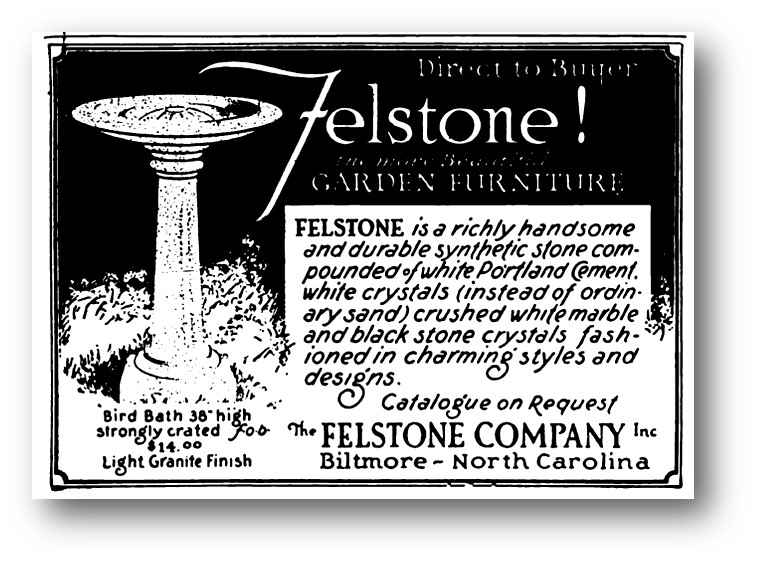 Let’s first start with a brief introduction to “C. Marshall Gravatt”. Gravatt was born, Charles Marshall Gravatt on June 24, 1887, to Dr. & Mrs. Charles Urquhart Gravatt, at Erie, Pennsylvania. The family soon moved back to Dr. Gravatt’s hometown of Port Royal, Virginia. Dr. Gravatt was a naval surgeon and physician before becoming a Democratic Senator in the Virginia Senate in 1908. The same year, his son Charles Marshall Gravatt, enrolled at the University of Virginia. Charles Marshall Gravatt graduated from the University of Virginia in 1912, and then spent a year (1912-13) working as a miner in Cripple Creek, CO and then as an assayer in Van Horn, TX, before re-enrolling at the University of Virginia in 1913 to pursue a degree in Mining Engineering.[1] While still a student at UVA, in August of 1914, C. Marshall Gravatt married Elizabeth McDowell Blanton at the Presbyterian Church in Charlottesville, VA.[2] Gravatt graduated from UVA the following June 1915. Marshall Gravatt then worked as a Mining Engineer in Virginia until the start of World War 1. From 1917-1919, Capt. Marshall Gravatt served as a Training Officer for the Expeditionary Forces in France, after which he returned to the U. S. and was re-assigned as an aviation instructor in San Diego, California. Unfortunately, in March of 1919, while the Gravatts were living in California, Mrs. Elizabeth Gravatt suddenly died from the effects of a surgery for an appendicitis, leaving her husband and their 3-year-old son.[3] A year later, in August 1920, Marshall Gravatt, having been discharged and now living back in Port Royal and working as a mining engineer, was married to Margaret S. Corkran, of Baltimore, MD.[4] The newlyweds settled in Port Royal, VA following their extended honeymoon in Central America. However, Port Royal was not to be their home for very long.
Let’s first start with a brief introduction to “C. Marshall Gravatt”. Gravatt was born, Charles Marshall Gravatt on June 24, 1887, to Dr. & Mrs. Charles Urquhart Gravatt, at Erie, Pennsylvania. The family soon moved back to Dr. Gravatt’s hometown of Port Royal, Virginia. Dr. Gravatt was a naval surgeon and physician before becoming a Democratic Senator in the Virginia Senate in 1908. The same year, his son Charles Marshall Gravatt, enrolled at the University of Virginia. Charles Marshall Gravatt graduated from the University of Virginia in 1912, and then spent a year (1912-13) working as a miner in Cripple Creek, CO and then as an assayer in Van Horn, TX, before re-enrolling at the University of Virginia in 1913 to pursue a degree in Mining Engineering.[1] While still a student at UVA, in August of 1914, C. Marshall Gravatt married Elizabeth McDowell Blanton at the Presbyterian Church in Charlottesville, VA.[2] Gravatt graduated from UVA the following June 1915. Marshall Gravatt then worked as a Mining Engineer in Virginia until the start of World War 1. From 1917-1919, Capt. Marshall Gravatt served as a Training Officer for the Expeditionary Forces in France, after which he returned to the U. S. and was re-assigned as an aviation instructor in San Diego, California. Unfortunately, in March of 1919, while the Gravatts were living in California, Mrs. Elizabeth Gravatt suddenly died from the effects of a surgery for an appendicitis, leaving her husband and their 3-year-old son.[3] A year later, in August 1920, Marshall Gravatt, having been discharged and now living back in Port Royal and working as a mining engineer, was married to Margaret S. Corkran, of Baltimore, MD.[4] The newlyweds settled in Port Royal, VA following their extended honeymoon in Central America. However, Port Royal was not to be their home for very long.
In January of 1921, Marshall Gravatt (of Port Royal, Virginia) purchased the leases on two mining operations in Buncombe County, North Carolina-the Bee Tree Mine (from the Blue Ridge Mineral Company) and the old Bede Smith mine (from the Standard Mica Company), both of which were in Swannanoa. Gravatt and his partner, Blair Taylor, also formed the Southern Spar & Mica Company, to prospect the two mines.[5] According to Mr. Gravatt, the newly purchased mines had the “finest quality of feldspar that had ever come under his observation as a mining expert, and he has examined specimens from various parts of the country”.[6] Since felspar was a prime mineral used in making pottery, Gravatt met with the Asheville Board of Trade to try to interest any businessmen in establishing a pottery plant. In the end, Gravatt himself, would establish his own pottery manufacturing plant.[7]
During the early twentieth century, Western North Carolina was a prime resource for mining of minerals, especially mica, quartz, and felspar. In a 1921 U. S. Government report on the mining of felspar, F. J. Katz reported that “North Carolina is the principal producing State, its output of crude feldspar in 1921 being nearly 45 per cent of the total for the United States and more than twice as much as that of the State next in rank. Individual reports were received on 40 quarries in Avery, Buncombe, Mitchell, and Yancey counties, and production from a considerable number of other small operations was reported by the larger producers, through whom the small quarrymen marketed their product.” [8] Katz further reported that the operators of two quarries, one at Micaville in Yancey County, and one at Swannanoa in Buncombe County, “have prepared to offset the heavy costs of production of No. 1 grade feldspar by crushing the large quantity of waste rock necessarily handled and disposing of the crushed product as material for concrete facing or for use in concrete aggregates or for other purposes.”[9] The quarry “at Swannanoa”, mentioned by Katz in the report, was the mine newly operated by the Southern Spar & Mica Company.[10] Southern Spar & Mica’s “quarry” was actually a “stope mine” (a stope is a dugout tunnel or space that contains the ore that is being mined) on land on the east side of the mountain in Kelly Cove, in Swannanoa.[11] Modern readers would know the area as on the northern section of Woodland Road, just northwest of the Black Mountain Children’s Home.
As mentioned in the 1921 Katz article, the uniqueness of the Southern Spar & Mica Company was that in addition to mining for minerals, the company had found a way to utilize the “large quantity of waste rock” that was produced in the mining operations, by crushing the rock to be used “as material for concrete facing or for use in concrete aggregates or for other purposes.”[12] Apparently, the former miners of the Southern Spar’s Swannanoa mine, had only been interested in extracting the mica from the mine, and as a result had dug through and discarded (thrown down the mountainside outside of the mine) tons of rock filled with feldspar deposits. Southern Spar and Mica not only reclaimed the formerly discarded rock, but also purposed to reuse the waste rock that they were currently removing from the mine.[13] To capitalize on this new “product”, Blair Taylor and C. Marshall Gravatt, along with C. G. Reininger, in 1922, formed the “Felstone Company”, in conjunction with (though separate from) the Southern Spar & Mica Company.[14] The company purchased a lease of land at the end of Fairview Road, just before where the road crossed the railroad tracks to intersect with Brook Street and Sweeten Creek Road, just east of Biltmore Village. Modern day readers would recognize the location as the site of the current CarePartners Estate Sales Thrift Store, at 75 Fairview Road. The Felstone Company commenced construction of its new manufacturing plant in May of 1922, and began production by July.[15]
The Felstone plant produced four types of products: pottery; lawn & garden ornaments; architectural trim; and concrete blocks. To produce these varied products, the company produced and used a synthetic stone, they named “Felstone”, which they advertised as, “a handsomely and durable synthetic stone, composed of white Portland cement, white crystals (instead of ordinary sand), crushed white marble and black stone crystals, fashioned in charming styles and designs”.[16] Felstone, was advertised as looking like, and as durable as granite, as Felstone was made using the same components as natural granite, black and white feldspar mica and quartz.[17] This blend of materials was used to make concrete blocks, which looked so much like stone, that they could be used like “stonework” and not have to be painted, very akin to our modern-day “ground-face block”.
A surviving 1925 Felstone catalog, titled, “A Book of Garden Furniture”[18] shows an array of garden “furniture”, which were mostly “ornaments”, such as planters, birdbaths, and sundials. Their styles ranged from ancient Celtic, classical, and even to simple “modern” arts & crafts designs. Only a few examples survive, that we know about. Besides a couple of surviving Felstone planters, the most notable piece of Felstone in the courtyard of the All Souls Cathedral, in Biltmore Village, is an original Felstone sundial. Originally bought in the 1920’s by Dr. Thomas Patton Cheesborough as a gift for his sister Septima Cheesborough, an avid gardener, who along with her sister Mary, and brother Joe, remained at Springvale, the Cheesborough homestead along the Swannanoa River (at the current entrance to River Hills Shopping Center). After the deaths of the three Cheesborough siblings at Springvale, the sundial was donated to All Souls as a memorial by their younger brother, James Walton Cheesborough. This sundial model is shown on page 9 of the 1925 catalog, though shown with an interchangeable birdbath on top. Another known Felstone product was a wellhead cover at the Burnham S. Colburn house at 7 Stuyvesant Road in Biltmore Forest, NC. The design of the wellhead used medieval Celtic motifs to give it an “Old World” style.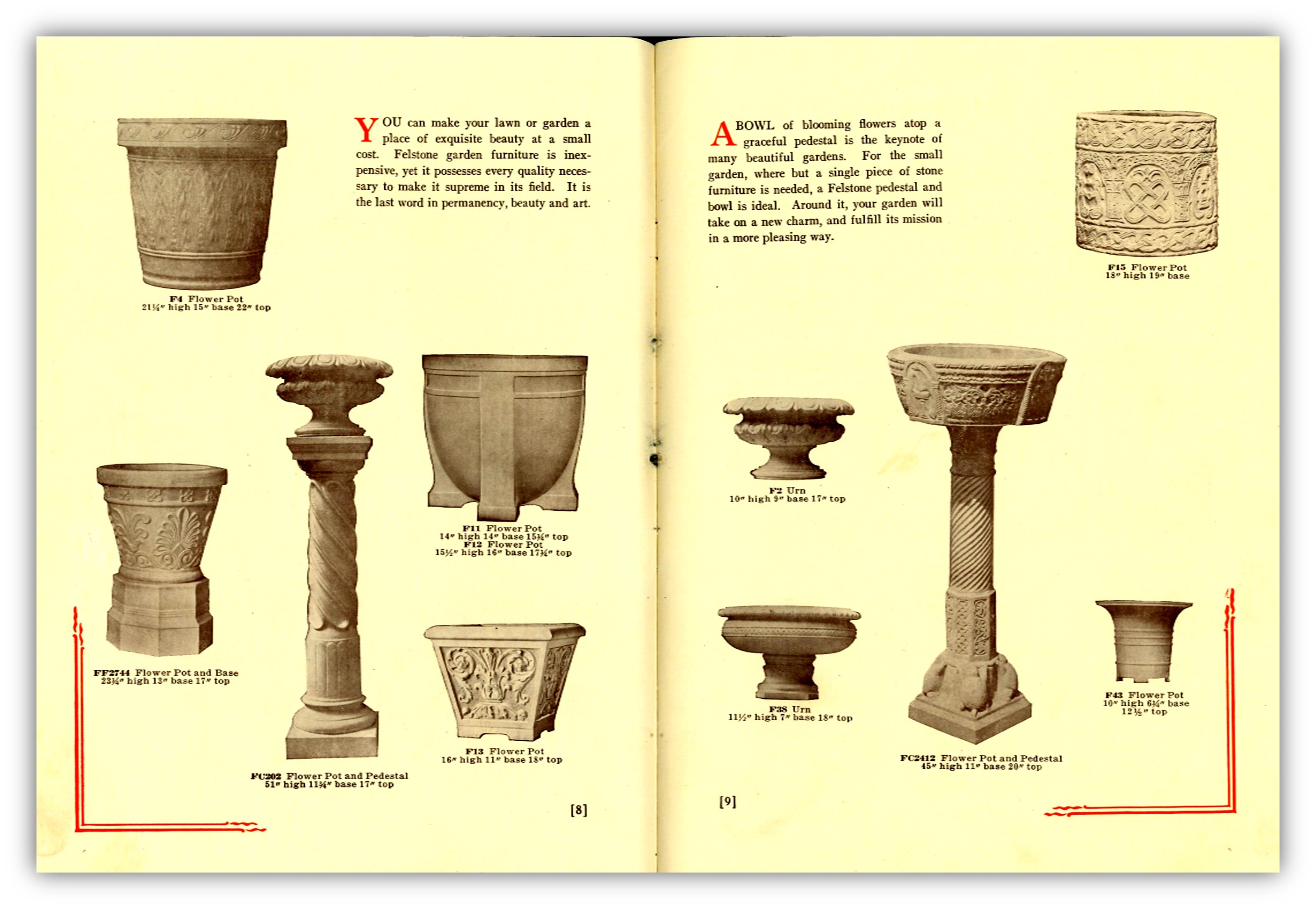
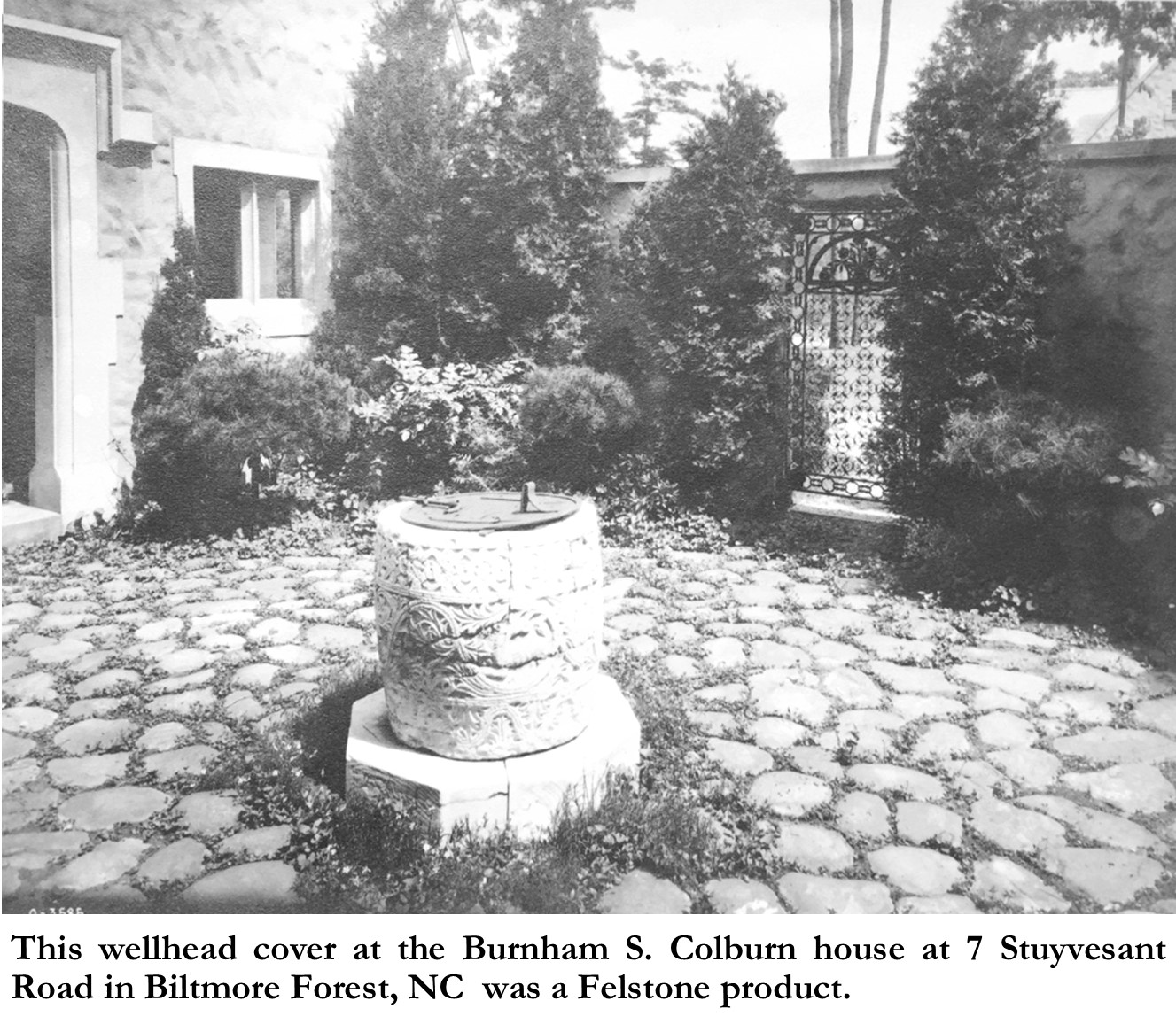
In addition to its manufactured lawn & garden ornaments, Felstone also produced synthetic-stone architectural ornaments and trim work. “FELSTONE-As An Ornament of the Building Itself” advertised the company in their 1925 catalog. It appears that their architectural trim work was all or mostly custom work, as the catalog showed no stock items, but merely showed six photos of buildings/houses that featured Felstone ornaments. There are six photos in the 1925 catalog, all of them have been identified, and five of the six photos are of houses, and all five are still existing in Asheville’s historic Grove Park neighborhood. The sixth photo is of a fountain in what appeared to be a courtyard. However, it turns out that the “courtyard” was the interior lobby of the former Plaza Theater, which sat on the southeast corner of Biltmore Avenue and Pack Square. The fountain shows in a vintage photo from a collage of images of the Plaza Theater. The original photos were taken in the 1920’s by George Masa, a Japanese immigrant, who had emigrated to Asheville, where he set up a photography business called “Plateau Studios”. Also shown in the Masa photo are numerous planters sitting around the lobby/courtyard. No doubt the planters were also made by and of “Felstone”.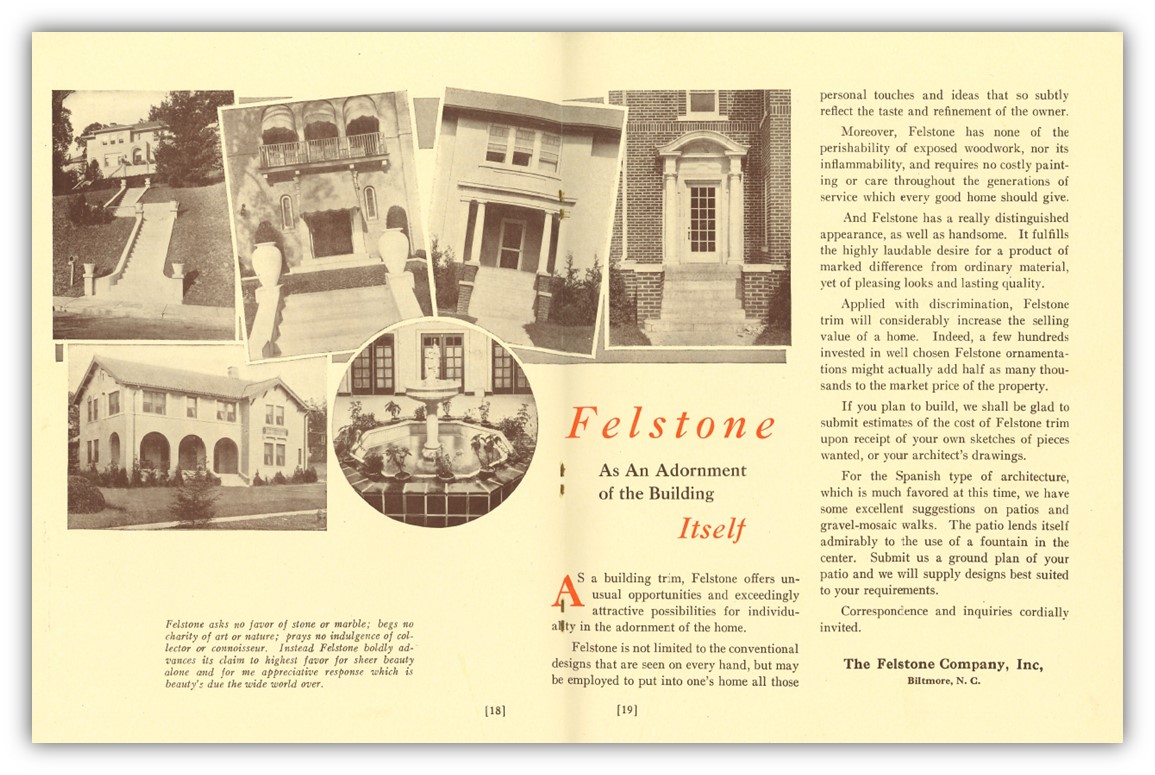
Let’s look at the five houses shown in the catalog, which are some of only a few surviving houses that we can definitely identify as using Felstone ornaments or architectural trim. The first house shown on the left of the top row, was built as a spec house by builder/developer, E. A. Jackson, at 52 Glendale Road, just off of Sunset Parkway in the Grove Park neighborhood. In fact, all five of the houses shown in the 1925 Felstone catalog were not only built in Grove Park, but were also built by a “Jackson”. In 1919, Edmund A. Jackson, who had moved his family to Asheville from Georgia, decided to sell his successful Chero-Cola business and go into fulltime real estate development. At first, he was joined by his entrepreneurial son, L. B. Jackson. However, in 1922, L. B. Jackson decided to launch out on his own by forming “L. B. Jackson & Company”. At that time, E. A. Jackson decided to form his own company, in partnership with another son, Robert P. Jackson, which he called “Jackson Realty”. Both companies “dealt in real estate”, meaning that they bought and sold properties, as well engaged in “real estate development”.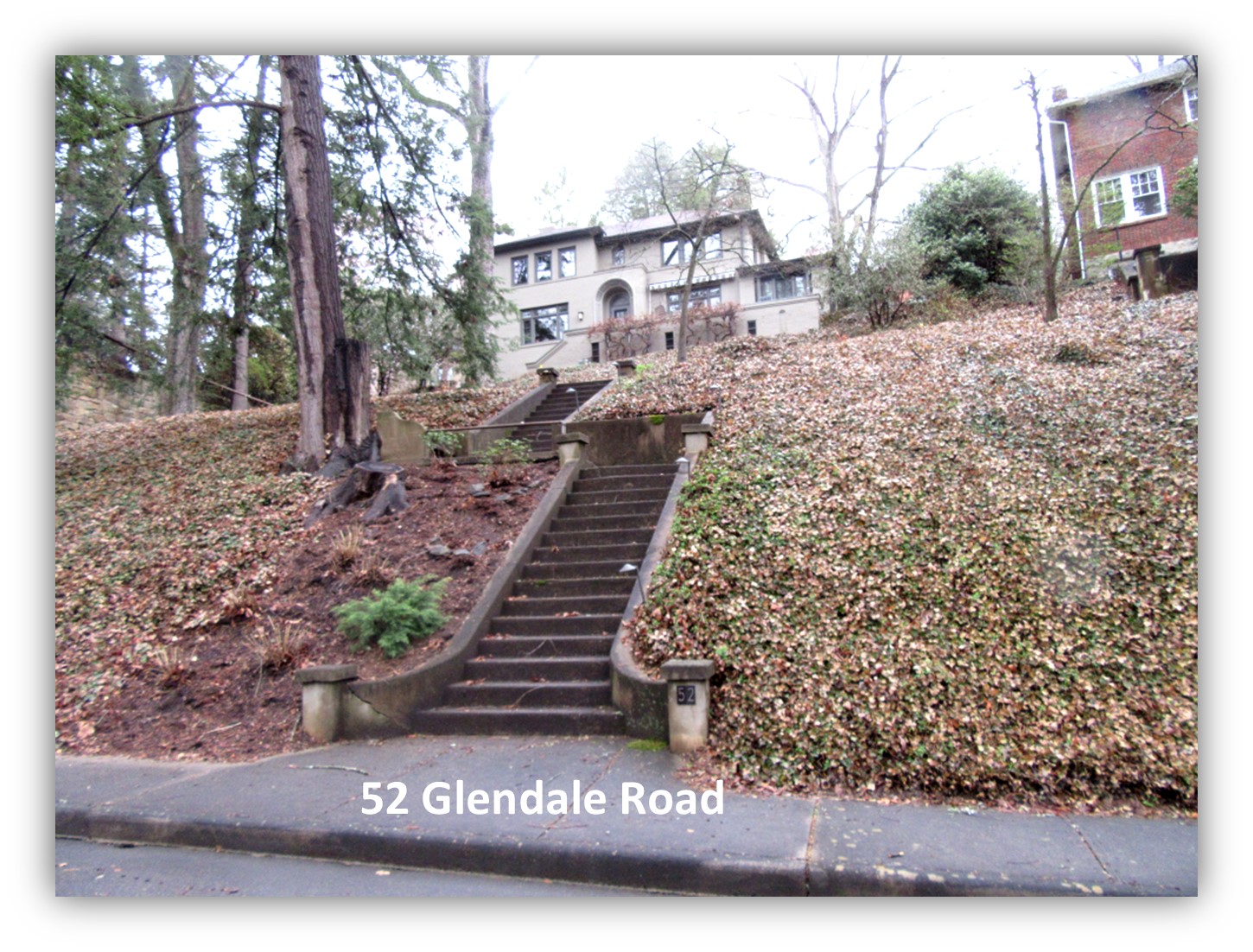 The house built by E. A. Jackson at 52 Glendale Road, was not an ordinary “spec house”, but was as it was advertised, “A Home for the Discriminating Buyer”.[19] That of course meant, an expensive high-end house, built in an upscale neighborhood. A distinctive feature of the house is its siting on the top of hill, accessed from the front by three long flights of stairs to the front yard, with a fourth flight of stairs up to the entrance terrace. Each set of stairs have flanking top and bottom square pier newel posts, which in the catalog were shown to be topped with Felstone planters. However, the most important and noticeable Felstone product used in the house is its unique recessed door-surround at its front entrance. It is like a Churrigueresque Spanish Baroque door surround interpreted in an Art Deco design, with its simple geometric incised lines and interlocking Celtic circles.
The house built by E. A. Jackson at 52 Glendale Road, was not an ordinary “spec house”, but was as it was advertised, “A Home for the Discriminating Buyer”.[19] That of course meant, an expensive high-end house, built in an upscale neighborhood. A distinctive feature of the house is its siting on the top of hill, accessed from the front by three long flights of stairs to the front yard, with a fourth flight of stairs up to the entrance terrace. Each set of stairs have flanking top and bottom square pier newel posts, which in the catalog were shown to be topped with Felstone planters. However, the most important and noticeable Felstone product used in the house is its unique recessed door-surround at its front entrance. It is like a Churrigueresque Spanish Baroque door surround interpreted in an Art Deco design, with its simple geometric incised lines and interlocking Celtic circles.
The second photo shown in the 1925 catalog, is a closeup of the front entrance of the W. R. Campbell house at 57 Woodland Road, also in Grove Park. I’m sure that Felstone must have been disappointed to not have taken a photo before their product was disguised behind a heavy awning. Today the Spanish Colonial-styled house proudly shows its Classical-columned Felstone door surround. The mortar joints between the blocks gives the appearance that the surround is made of carved stone blocks, though they are actually pre-cast synthetic “stone” blocks. The W. R. Campbell house at 57 Woodland Road was built in 1923 by the short-lived “Grove Park Construction Company”.
“COMPANY FORMED TO ERECT HOMES IN GROVE PARK: FOUR STARTED AT COST OF $75,000”, announced the October 29, 1922, edition of the Asheville Citizen-Times.[20] The Grove Park Construction Company was founded by W. R. Campbell in 1922, in partnership with Junius S. Adams and L. B. Jackson. This was the same year that Jackson had formed the L. B. Jackson & Company. W. R. Campbell, who was also the sales manager for Mr. Grove’s Grove Park development, served as President of the new Grove Park Construction Company (not affiliated with Mr. Grove) and L. B. Jackson served as the Secretary-Treasurer and “active manager”.[21]
The above-mentioned 1922 article of the forming of the Grove Park Construction Company, further reported that the new company had already started building four houses on “Kimberly Road” [Kimberly Avenue].[22] Comparing dates and contemporary reports, it is obvious that three of those four houses, were the three other houses featured in the Felstone catalog. The first of the three to show in the catalog was the house built by the company at 84 Kimberly Avenue. The photo in the catalog is a closeup of the “stone” Doric- in-antis columned entranceway arch, which was obviously a Felstone product. 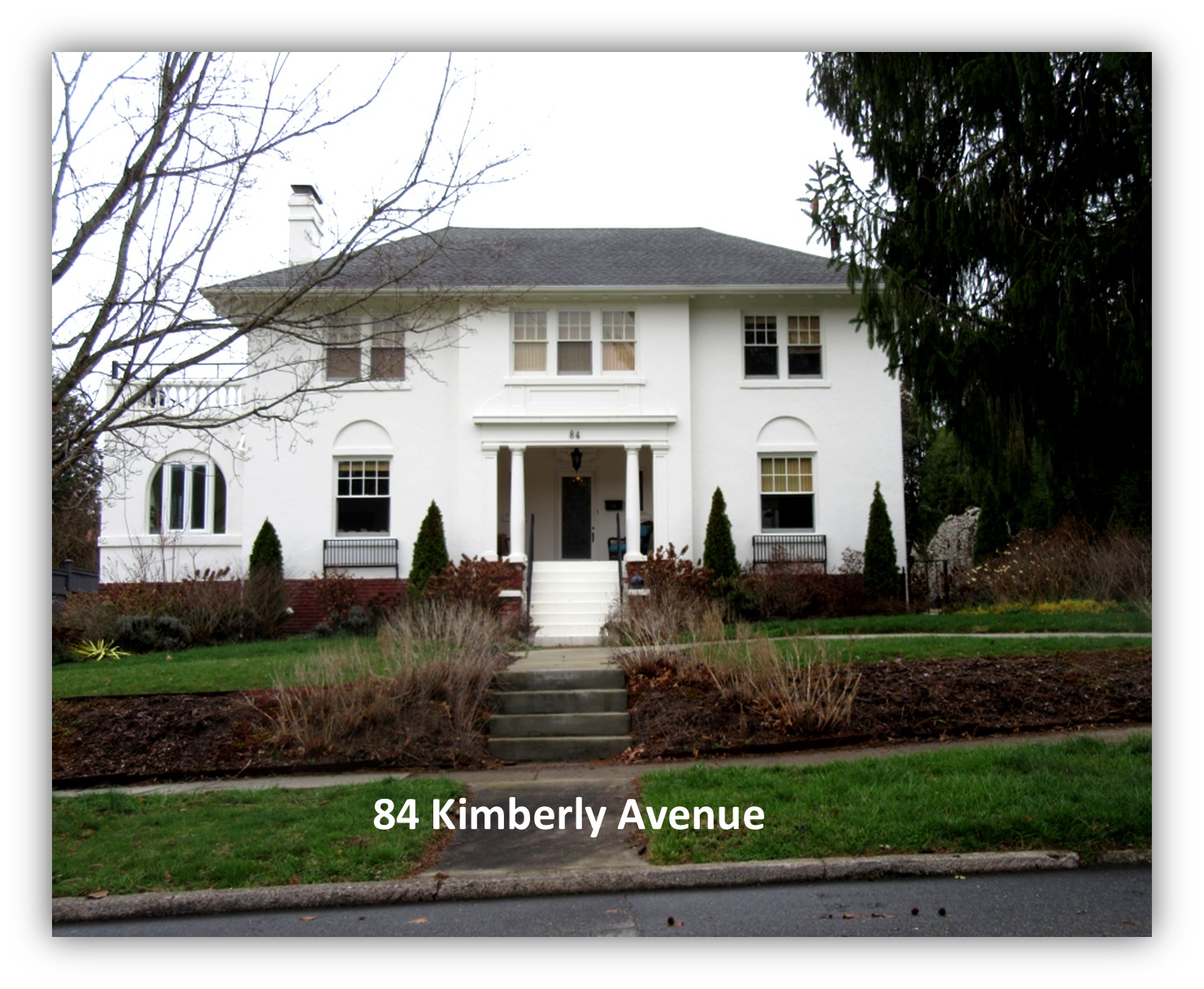
The second of the three houses built on Kimberly Avenue to show in the catalog, was the house built at 62 Kimberly Avenue. It’s obvious from the closeup photo shown in the catalog that the beautifully detailed Classical door surround, was another fine “product” of Felstone Company. The third of the three houses built by the Grove Park Construction Company that shows in the Felstone catalog, is the house built at 98 Kimberly Avenue. The Spanish-Colonial designed house features unique turned-columned Felstone window surrounds at the second-floor windows. An interesting detail is the double columns used at the southeast corner of the second floor. The integral window sill/belt course on the second floor may also be made of Felstone? Had the Felstone Company purposefully partnered with the Grove Park Company to feature their product? It does seem likely.
The third of the three houses built by the Grove Park Construction Company that shows in the Felstone catalog, is the house built at 98 Kimberly Avenue. The Spanish-Colonial designed house features unique turned-columned Felstone window surrounds at the second-floor windows. An interesting detail is the double columns used at the southeast corner of the second floor. The integral window sill/belt course on the second floor may also be made of Felstone? Had the Felstone Company purposefully partnered with the Grove Park Company to feature their product? It does seem likely.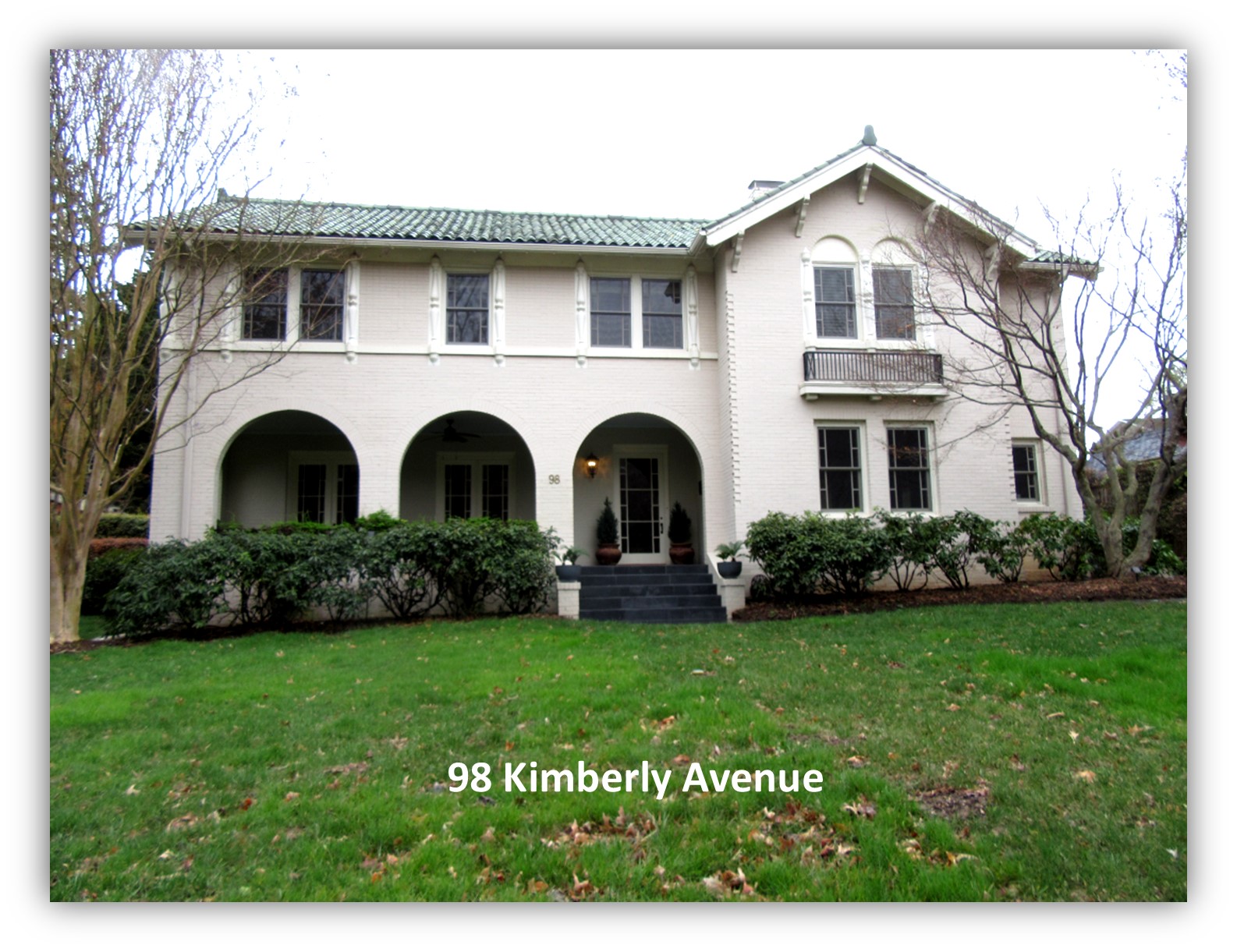 Another known use of “Felstone” products on a local building, though not mentioned in the 1925 catalog, was on the “Harmon Miller Building”, built in 1925 on Patton Avenue. At the completion of the building, which was being leased by the Tanenhaus Bros. clothier, the Felstone Company published an advertisement in the Asheville Citizen-Times announcing their involvement in the construction of the new building: “Tanenhaus Bros., Inc, WE WELCOME YOU to ASHEVILLE and are pleased to have a part in building your new home. The stone in the HARMON MILLER BUILDING is FELSTONE.”[23] The building which is still standing and in use at 90 Patton Avenue, still displays its Felstone trim at the third story windows and top coping stones. However, a vintage postcard photo shows that the original Tanenhaus Bros. storefront included Felstone blocks at its front and possibly on its recessed entrance walls. It also appears that the arched tiled ceiling in the recessed entry may have been made of Felstone as well. The original storefront has since been altered beyond recognition.
Another known use of “Felstone” products on a local building, though not mentioned in the 1925 catalog, was on the “Harmon Miller Building”, built in 1925 on Patton Avenue. At the completion of the building, which was being leased by the Tanenhaus Bros. clothier, the Felstone Company published an advertisement in the Asheville Citizen-Times announcing their involvement in the construction of the new building: “Tanenhaus Bros., Inc, WE WELCOME YOU to ASHEVILLE and are pleased to have a part in building your new home. The stone in the HARMON MILLER BUILDING is FELSTONE.”[23] The building which is still standing and in use at 90 Patton Avenue, still displays its Felstone trim at the third story windows and top coping stones. However, a vintage postcard photo shows that the original Tanenhaus Bros. storefront included Felstone blocks at its front and possibly on its recessed entrance walls. It also appears that the arched tiled ceiling in the recessed entry may have been made of Felstone as well. The original storefront has since been altered beyond recognition.
In addition to its pottery, lawn & garden ornaments, and architectural trim, the Felstone Company also produced a specialty concrete block. In a December 1922 newspaper article, Irwin T. Caton described the process for making the Felstone block: “The concrete building blocks are made of sand and gravel mixed with cement, while the Felstone blocks are made of ground stone and gravel mixed with cement. The proportions of 2-D grade and 1-E grade [graded stones] makes a very beautiful block. In the making of building blocks and facings the mold is first made for the desired shape and size; the concrete poured in and hardened; the mold removed and the piece washed off with bi-chloric acid to bring out the crystals of the stones. Each block costs 30 cents less than that of 12 bricks.”[24] 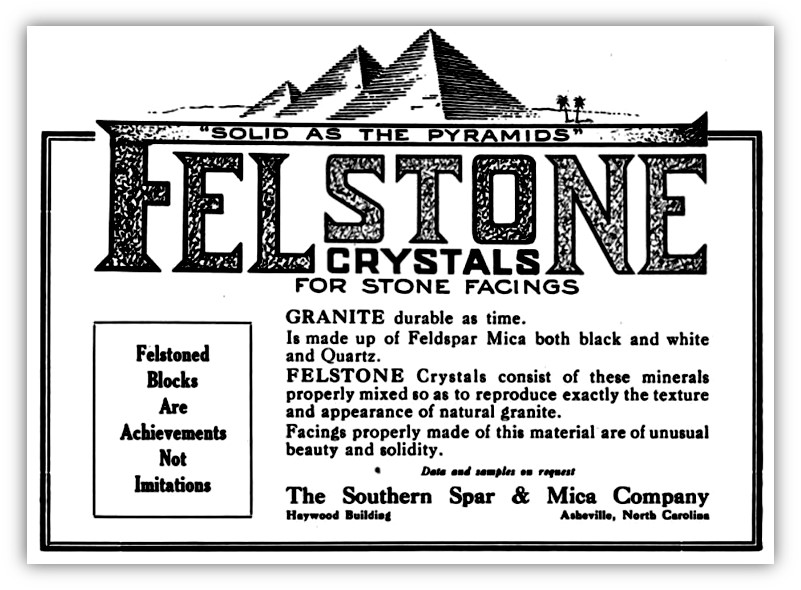
The above-mentioned article further reported that “The first house in Asheville to be built of Felstone blocks is on Tacoma Street, the second to be erected in Biltmore Forest.”[25] The “first house” was built at 28 Tacoma Street (now addressed as 32 Tacoma St.) in the Montford neighborhood of Asheville. The “second” house, which was mentioned “to be erected in Biltmore Forest”, was actually built in Biltmore Village at 38 All Souls Crescent. Let’s take a look at each house.
In 1919, E. M. Rawls platted out the lots on the southside of Tacoma Street,[26] and in October 1921, Rawls sold lot #1 to Frederick Reeves Rutledge,[27] an Asheville insurance agent. A year later Rutledge borrowed $3,800 from the Blue Ridge Building & Loan Association,[28] to begin building a house on the lot. Although it is clear that Rutledge was the one who commissioned the house to be built, it is unclear who the architect and/or builder was, and more apropos, it is unclear how/why Rutledge chose to build his house of “Felstone Block”?
The house that Rutledge had built at 32 Tacoma Street is the only known surviving example of a house that was built with Felstone concrete block. A recent former owner of the house would often refer to the house as “The Sparkle House”, as the ground mica flecks in the blocks really do “sparkle” in the sunlight, resembling bits of silver. What made the Felstone blocks so attractive was that the crushed stones used to form the blocks were the “waste product” stones resulting from the mineral mining operations of the Southern Spar & Mica Company. The stone contained flecks of minerals such as mica and quartz, as well as bits of black and white Georgia marble. The Felstone blocks used on the house were quite large, measuring 9 inches high by 24 inches long, and 6-8 inches thick. Also, the exterior windowsills and lintels were made of Felstone as well. Also, the Felstone blocks along the bottom of the first-floor walls were designed to project about 1 inch from the blocks above and had a beveled top. This bottom row of beveled Felstone blocks formed a “water-table” base around the house, which was in keeping with its Colonial Revival design.
The “second” house, which was mentioned “to be erected in Biltmore Forest”, was actually built in Biltmore Village at 38 All Souls Crescent for Minnie Young Warrington and her sister Frances Young.[29] Very little is known about how and why this house was built of Felstone blocks. So far, the only surviving photo of the house is on an early 1950’s aerial.[30] The photo shows a two-story house with a reverse saltbox roof. The house at 32 All Souls Crescent was damaged by the Highway Commission in 1970, during a road-widening, and in 1972, after compensating the owners, the Highway Commission tore down the house.
Felstone products, though made in the 1920’s, today would be thought of as an eco-friendly product, having been made of natural rocks, minerals, and cement, and having been mined and manufactured “locally”! The Felstone Company did not survive the Great Depression of the 1930’s, but its legacy, though little-known, remains today in Asheville on houses and buildings in its historic neighborhoods. The story of this 1920’s phenomenon of Asheville/Buncombe County’s architectural history has been mostly lost; however, a few remnants remain, and hopefully more will be discovered (uncovered) in the future.
Photo & Image Credits: (Note: All photos not listed below by Dale Wayne Slusser; Also all cropping and captions by author)
Felstone Garden Furniture Advertisement- Garden Magazine & Home Builder. United States, Doubleday, 1924, page 437. -googlebooks.com
Photo of C. M. Gravatt- Photo caption: “Lt. Charles Gravatt, off duty, Saints, July 1918”-accessed from Find-A-Grave, photo posted by MARK, Find a Grave ID 47274205.
Felstone Lawn & Garden Ornaments-Catalog Page- “A Book of Biltmore, NC: The Felstone Company), 1925, pages 8-9. -Scan by and from Robert Griffin, Griffin Architects, P. A., Biltmore Village.
Felstone Wellhead at Colburn House- -Scan by and from Robert Griffin, Griffin Architects, P. A., Biltmore Village.
“Felstone As An Ornament to the Building Itself”-Catalog Page- “A Book of Biltmore, NC: The Felstone Company), 1925, pages 18-19. -Scan by and from Robert Griffin, Griffin Architects, P. A., Biltmore Village.
Photo of 86 Patton Avenue-from the 86 Patton Avenue-Property Card at the Buncombe County Register of Deeds.
Postcard of Tanenhause Bros. Storefront- Image #AD807- Tanenhaus Brothers, “The Square Deal Store”, 90 Patton Ave, Asheville, N.C. -Buncombe County Special Collections, Pack Memorial Library, Asheville, NC.
Felstone Crystals- Advertisement from: Concrete. United States, Concrete Publishing Corporation, 1922., page 102.
Closeup of 38 All Souls Crescent on Aerial- Image #K498-8-Biltmore Village from the air. -Buncombe County Special Collections, Pack Memorial Library, Asheville, NC.
[1] Bulletin of the American Institute of Mining Engineers, Issues 121-125, The American Institute of Mining Engineers, 1916, page xxix.
[2] “Virginia Weddings”, The Washington Post, Washington, DC, August 16, 1914, page 3. -newspapers.com
[3] “Mrs. Marshall Gravatt Dead”, The Free Lance Star, Fredericksburg, VA, March 4, 1919, page 3; AND The Lexington Herald, Lexington, VA, March 4, 1919, page 6. -newspapers.com
[4] “Gravatt-Corkran”, The Free Lance Star, Fredericksburg, VA, August 19, 1920, page 1. -newspapers.com
[5] “Pottery In Prospect Soon”, Asheville Citizen-Times, January 11, 1921, page 9. -newspapers.com
[6] The Charlotte Observer, Charlotte, NC, January 26, 1921, page 14. -newspapers.com
[7] “MUCH INTEREST IN ARROUSED IN PLANT”, Asheville Citizen-Times, February 14, 1921, page 11. -newspapers.com
[8] “Feldspar” by F. J. Katz (August 30, 1922) From: Mineral Resources of the United States, Part II, 1921. (Washington, DC: Government Printing Office, 1924), pages 113.
[9] Ibid.
[10] 03/21/1921 C. Marshall Gravatt, TR & Blair Taylor, TR to Southern Spar & Mica Co [D/T] DECLARATION OF TRUST Db. 135/630. -Buncombe County Register of Deeds.
[11] “Tremendous Deposits of Unusually Rich Feldspar”, Asheville Citizen-Times, January 19, 1922, page 11. -newspapers.com
[12] Ibid.
[13] Ibid.
[14] The Charlotte Observer, Charlotte, NC, May 2, 1922, page 6. -newspapers.com
[15] “FELSTONE COMPANY IS NOW PRODUCING”, Asheville Citizen-Times, July 1, 1922, page 12. -newspapers.com
[16] Felstone Advertisement from: Garden Magazine & Home Builder. United States, Doubleday, 1924, page 437.- googlebooks.com
[17] Felstone Crystals advertisement: Concrete., a periodical publishing by United States, Concrete Publishing Corporation, 1922., page 102. -googlebooks.com
[18] “A Book of Garden Furniture”, The Felstone Company, Biltmore, NC, 1925. -Courtesy of Robert Griffin, architect-Asheville, NC.
[19] “A Home For the Discriminating Buyer”, advertisement, Asheville Citizen-Times, February 24, 1924, page 19. -newspapers.com
[20] “COMPANY FORMED TO ERECT HOMES IN GROVE PARK: FOUR STARTED AT COST OF $75,000”, Asheville Citizen-Times, October 29, 1922, page 27. -newspapers.com
[21] 10/13/1922 -GROVE PARK CONSTRUCTION CO. [INC] Db. C006/120. -Buncombe County Register of Deeds.
[22] “COMPANY FORMED TO ERECT HOMES IN GROVE PARK: FOUR STARTED AT COST OF $75,000”, Asheville Citizen-Times, October 29, 1922, page 27. -newspapers.com
[23] Asheville Citizen-Times, April 16, 1925, page 10. -newspapers.com
[24] “The Felstone Company”, by Irwin T. Caton, Asheville Citizen-Times, December 10, 1922, page 35. -newspapers.com
[25] Ibid.
[26] 01/01/1919 E. M. Rawls PLAT TACOMA & ENOREE STRE ET Db. 154/195. -Buncombe County Register of Deeds.
[27] 10/20/1921 E. M. Rawls to F. Reeves Rutledge LOT 1 BK 154 P 195 Db. 251/513. -Buncombe County Register of Deeds.
[28] 10/02/1922 F. Reeves & Ruth Rutledge to Citizens Bank, TR; Blue Ridge Building & Loan [D/T] TACOMA ST Db. 151/219. “for $3,800…indebted to the Blue Ridge Building & Loan…”.
[29] 7/19/1922 L. B. Jackson to Minnie Young Warrenton & Frances Young NEAR ALL SOULS CHURCH Db. 259/199. -Buncombe County Register of Deeds.
[30] Image #K498-8- Biltmore Village from the Air, Buncombe County Special Collections, Pack Memorial Library, Asheville, NC.


